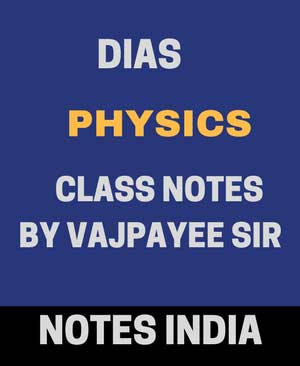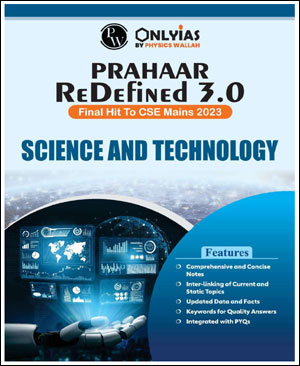DIAS Physics Class Notes Vol [1 to 8] for UPSC by Vajpayee Sir
DIAS Physics Notes Vol (1 to 8) for UPSC by Vajpayee Sir .That is the reason DIAS exists. To help you seek after your fantasy. This is a remarkable stage for Test Preparation where you can get to live classrooms of the best instructors in India, from the solace of your home. DIAS offers you master direction for Civil Services exams, from doyens in this field, top educators from well known IAS instructing organizations in Delhi, who have had years of involvement in effectively coaching the possibility to build up a comprehensive way to deal with their planning for the exams. They have sustained and made toppers. Presently, the ball is in your court to be one. DIAS will convey the best to you!
Under the dynamic administration of our guide eminent Civil Services Guru D.P. Vajpayee , B. Tech IIT( Bombay), M.Phil (JNU), DIAS has kept up its record of walk towards greatness. He covers the syllabus very nicely.We must say there can’t be any guide better than Vajpeyi Sir for Physics.This is one of the best study material of UPSC Main which is photocopy notes of Printed Material and Hand written class notes of D.P Vajpayee Sir.
Physics Syllabus for Main Examination
PAPER – I
1.
- Mechanics of Particles: Laws of motion; conservation of energy and momentum, applications to rotating frames, cent r ipetal and Cor iol is accelerat ions; Motion under a central force; Conservation of angular momentum, Kepler’s laws; Fields and potentials; Gravitational field and potential due to spherical bodies, Gauss and Poisson equations, gravitational self-energy; Two-body problem; Reduced mass; Rutherford scattering; Centre of mass an laboratory reference frames.
- Mechanics of Rigid Bodies: System of particles; Centre of mass, angular momentum, equations of motion; Conservation theorems for energy, momentum and angular momentum; Elastic and inelastic collisions; Rigid body; Degrees of freedom, Euler’s theorem, angular velocity, angular momentum, moments of inertia, theorems of parallel and perpendicular axes, equation of motion for rotation; Molecular rotations (as rigid bodies); Di and tri-atomic molecules; Precessional motion; top, gyroscope.
- Mechanics of Continuous Media: Elasticity, Hooke’s law and elastic constants of isotropic solids and their inter-relation; Streamline (Laminar) flow, viscosity, Poiseuille’s equation, Bernoulli’s equation, Stokes’ law and applications.
- Special Relativity: Michelson-Morley experiment and its implications; Lorentz transformations-length contraction, time dilation, addition of relativistic velocities, aberration and Doppler effect, mass-energy relation, simple applications to a decay process; Four dimensional momentum vector; Covariance of equations of physics.
2. Waves and Optics:
- Waves: Simple harmonic motion, damped oscillation, forced oscillation and resonance; Beats; Stationary waves in a string; Pulses and wave packets; Phase and group velocities; Reflection and Refraction from Huygens’ principle.
- Geometrical Optics: Laws of reflection and refraction from Fermat’s principle ; Matrix method in paraxial optics-thin lens formula, nodal planes, system of two thin lenses, chromatic and spherical aberrations.
- Interference: Interference of light-Young’s experiment, Newton’s rings, interference by thin films, Michelson interferometer; Multiple beam interference and Fabry-Perot interferometer.
- Diffraction: Fraunhofer diffraction-single slit, double slit, diffraction grating, resolving power; Diffraction by a circular aperture and the Airy pattern; Fresnel diffraction: half-period zones and zone plates, circular aperture.
- Polarization and Modern Optics: Production and detection of linearly and circularly polarized light; Double refraction, quarter wave plate; Optical activity; Principles of fibre optics, attenuation; Pulse dispersion in step index and parabolic index f ibres; Mater ial dispersion, single mode fibres; Lasers-Einstein A and B coefficients; Ruby and He-Ne lasers; Characteristics of laser light-spatial and temporal coherence; Focusing of laser beams; Three-level scheme for laser operation; Holography and simple applications.
3. Electricity and Magnetism:
- Electrostatics and Magnetostatics: Laplace and Poisson equations in electrostatics and their applications; Energy of a system of charges, multipole expansion of scalar potential; Method of images and its applications; Potential and field due to a dipole, force and torque on a dipole in an external field; Dielectrics, polarization; Solutions to boundary-value problems-conducting and dielectric spheres in a uniform electric field; Magnetic shell, uniformly magnetized sphere; Ferromagnetic materials, hysteresis, energy loss.
- Current Electricity: Kirchhoff’s laws and their applications; Biot-Savart law, Ampere’s law, Faraday’s law, Lenz’ law; Self-and mutual-inductances; Mean and r m s values in AC circuits; DC and AC circuits with R, L and C components; Series and parallel resonances; Quality factor; Principle of transformer.
- Electromagnetic Waves and Blackbody Radiation: Displacement current and Maxwell’s equations; Wave equations in vacuum, Poynting theorem; Vector and scalar potentials; Electromagnetic field tensor, covariance of Maxwell’s equations; Wave equations in isotropic dielectrics, reflection and refraction at the boundary of two dielectrics; Fresnel’s relations; Total internal reflection; Normal and anomalous dispersion; Rayleigh scattering; Blackbody radiation and Planck’s radiation law, Stefan – Boltzmann law, Wien’s displacement law and Rayleigh-Jeans’ law.
4.Thermal and Statistical Physics:
- Thermodynamics: Laws of thermodynamics, reversible and irreversible processes, entropy; Isothermal, adiabatic, isobaric, isochoric processes and entropy changes; Otto and Diesel engines, Gibbs’ phase rule and chemical potential; van der Waals equation of state of a real gas, critical constants; Maxwell-Boltzman distribution of molecular velocities, transport phenomena, equipartition and virial theorems; Dulong-Pet i t , Einstein, and Debye’s theories of specific heat of solids; Maxwell relations and applications ; Clausius- Clapeyron equation; Adiabatic demagnetisation, Joule-Kelvin effect and liquefaction of
Lorem ipsum dolor sit amet, consetetur sadipscing elitr, sed diam nonumy eirmod tempor invidunt ut labore et dolore magna aliquyam erat, sed diam voluptua. At vero eos et accusam et justo duo dolores et ea rebum. Stet clita kasd gubergren, no sea takimata sanctus est Lorem ipsum dolor sit amet. Lorem ipsum dolor sit amet, consetetur sadipscing elitr, sed diam nonumy eirmod tempor invidunt ut labore et dolore magna aliquyam erat, sed diam voluptua.
At vero eos et accusam et justo duo dolores et ea rebum. Stet clita kasd gubergren, no sea takimata sanctus est Lorem ipsum dolor sit amet. Lorem ipsum dolor sit amet, consetetur sadipscing elitr.
Sed diam nonumy eirmod tempor invidunt ut labore et dolore magna aliquyam erat, sed diam voluptua. At vero eos et accusam et justo duo dolores et ea rebum. Stet clita kasd gubergren, no sea takimata sanctus est Lorem ipsum dolor sit amet.
Related Products
Delhi UPSC Secrets - For UPSC CSE Prelims 2024 - CSAT Compre
Lorem ipsum dolor sit amet, consetetur sadipscing elitr, sed diam nonumy eirmod tempor invidunt ut l..
Only Ias - Physics Wallah - Prahaar 3.0 - World History - CS
Lorem ipsum dolor sit amet, consetetur sadipscing elitr, sed diam nonumy eirmod tempor invidunt ut l..
Only Ias - Physics Wallah - Prahaar 3.0 - Environment & Ecol
Lorem ipsum dolor sit amet, consetetur sadipscing elitr, sed diam nonumy eirmod tempor invidunt ut l..
Only Ias - Physics Wallah - Prahaar 3.0 - Internal Security
Lorem ipsum dolor sit amet, consetetur sadipscing elitr, sed diam nonumy eirmod tempor invidunt ut l..
Only Ias - Physics Wallah - Prahaar 3.0 - Social Issues - CS
Lorem ipsum dolor sit amet, consetetur sadipscing elitr, sed diam nonumy eirmod tempor invidunt ut l..
Only Ias - Physics Wallah - Prahaar 3.0 - Science & Technolo
Lorem ipsum dolor sit amet, consetetur sadipscing elitr, sed diam nonumy eirmod tempor invidunt ut l..
Only IAS - Physics Wallah - UPSC Mains Previous 11 Year’s
Lorem ipsum dolor sit amet, consetetur sadipscing elitr, sed diam nonumy eirmod tempor invidunt ut l..
Insights Ias - Monthly Magazine - Current Affairs 30 - April
Lorem ipsum dolor sit amet, consetetur sadipscing elitr, sed diam nonumy eirmod tempor invidunt ut l..
Forum Ias - Indian Polity Class Notes Part 1+2 - GS Foundati
Lorem ipsum dolor sit amet, consetetur sadipscing elitr, sed diam nonumy eirmod tempor invidunt ut l..
Toppers Notes - Mridul Shivhare - Rank-247, CSE-2021 - Theme
Lorem ipsum dolor sit amet, consetetur sadipscing elitr, sed diam nonumy eirmod tempor invidunt ut l..











